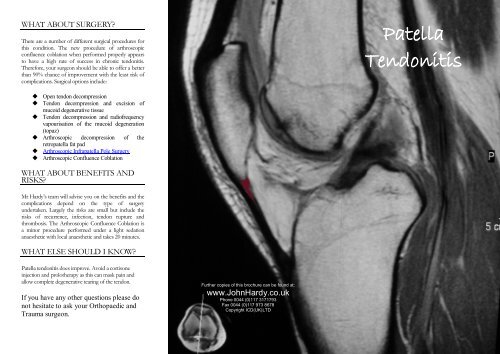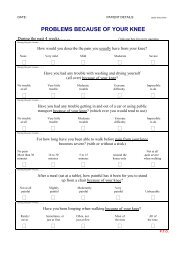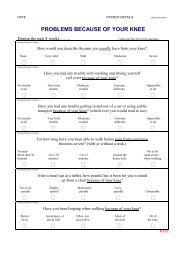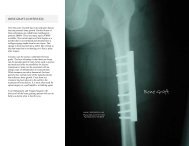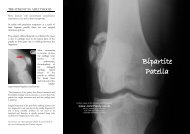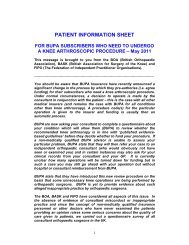Patella Tendonitis - Knee Surgeon
Patella Tendonitis - Knee Surgeon
Patella Tendonitis - Knee Surgeon
Create successful ePaper yourself
Turn your PDF publications into a flip-book with our unique Google optimized e-Paper software.
WHAT ABOUT SURGERY?<br />
There are a number of different surgical procedures for<br />
this condition. The new procedure of arthroscopic<br />
confluence coblation when performed properly appears<br />
to have a high rate of success in chronic tendonitis.<br />
Therefore, your surgeon should be able to offer a better<br />
than 90% chance of improvement with the least risk of<br />
complications. Surgical options include:<br />
<strong>Patella</strong><br />
<strong>Tendonitis</strong><br />
Open tendon decompression<br />
Tendon decompression and excision of<br />
mucoid degenerative tissue<br />
Tendon decompression and radiofrequency<br />
vapourisation of the mucoid degeneration<br />
(topaz)<br />
Arthroscopic decompression of the<br />
retropatella fat pad<br />
Arthroscopic Infrapatella Pole Surgery<br />
Arthroscopic Confluence Coblation<br />
WHAT ABOUT BENEFITS AND<br />
RISKS?<br />
Mr Hardy’s team will advise you on the benefits and the<br />
complications depend on the type of surgery<br />
undertaken. Largely the risks are small but include the<br />
risks of recurrence, infection, tendon rupture and<br />
thrombosis. The Arthroscopic Confluence Coblation is<br />
a minor procedure performed under a light sedation<br />
anaesthetic with local anaesthetic and takes 20 minutes.<br />
WHAT ELSE SHOULD I KNOW?<br />
<strong>Patella</strong> tendonitis does improve. Avoid a cortisone<br />
injection and prolotherapy as this can mask pain and<br />
allow complete degenerative tearing of the tendon.<br />
If you have any other questions please do<br />
not hesitate to ask your Orthopaedic and<br />
Trauma surgeon.<br />
Further copies of this brochure can be found at:<br />
www.JohnHardy.co.uk<br />
Phone 0044 (0)117 3171793<br />
Fax 0044 (0)117 973 8678<br />
Copyright ICD(UK)LTD
PATELLA<br />
TENDONITIS<br />
<strong>Patella</strong>r tendonpathy is a common sport related injury. It is<br />
most common in jumping and running sports. It is now<br />
curable.<br />
The newest hypothesis is that it probably results from a local<br />
fluid pump set up in the region of the origin of the ligamentum<br />
mucosum and the inferior pole of the patella. Consistent with<br />
this is that there are no inflammatory cells and no increase in<br />
prostaglandins can be detected in the tendons.<br />
Histopathological studies of the tissue fibrils affected by<br />
tendinopathy characteristically demonstrate hypercellularity,<br />
hypervascularity, lack of inflammatory infiltrates, and<br />
disorganisation and loosening of collagen fibres. There is no<br />
evidence that impingement is the cause of the tendonopathy.<br />
Therefore, while arthroscopic resection of the lower pole of the<br />
patella appears to work well the surgery does not make sense<br />
and leaves many athletes disabled by this aggressive surgery. A<br />
more considered approach is available. MRI studies show<br />
oedema of the tendon in its posterior fibres, fat pad and<br />
occasionally inferior pole of the patella. It may occur at any<br />
location along the patellar tendon, but the most commonly<br />
affected site is beneath the inferior pole of the patella. It also<br />
appears commonly in athletes who have suffered overuse<br />
injuries of the patella as a child and “jumpers knee” as an adult.<br />
The closest hypothesis to fit all of these observations is that the<br />
patella tendonopathy is due to an abnormal synovial fluid<br />
pump at the confluence of<br />
structures (the confluence of the<br />
medial plica, lateral plica,<br />
infrapatella plica and fat pad) at<br />
the inferior pole of the patella set<br />
up by compression during flexion<br />
of the upper part of Hoffa’s fat<br />
pad and the inferior pole of the<br />
patella.<br />
Figure 1 The red arrow<br />
points to an enlarged<br />
inferior pole of the<br />
patella in an adult with<br />
patella tendonitis and a<br />
history of Sinding-<br />
Larsen-Johansson<br />
disease (SLJ).<br />
Synovial fluid is irritant to<br />
extra-articular tissues. In a<br />
similar manner to the way a<br />
horizontal tear of the lateral<br />
meniscus sets up a pump<br />
mechanism to create a<br />
parameniscal cyst this pump drives the irritant joint fluid<br />
in and around the fibres of the patella tendon.<br />
HOW DO I KNOW IF I HAVE<br />
PATELLA TENDONITIS?<br />
The General Practitioner, or Orthopaedic and Trauma<br />
<strong>Surgeon</strong> you see will take a history, examine you and<br />
organise special investigations if necessary. The common<br />
Symptoms and Signs include:<br />
Pain in the front of your knee climbing stairs<br />
or slopes<br />
Pain that is worse first thing in the morning<br />
Swelling is rare<br />
Tenderness along the patella tendon worse<br />
with the knee straight rather than bent<br />
MRI is the investigation of choice<br />
Figure 2 MRI of left knee showing<br />
oedema of the deep fat pad.<br />
Plain radiographs are useful to distinguish<br />
this from Sinding-Larsen-Johansson<br />
syndrome.<br />
WHAT TREATMENTS ARE<br />
THERE?<br />
Most doctors will recommend conservative measures to<br />
try and control symptoms:<br />
Stopping the activity that caused the injury (rest)<br />
Ice or cold therapy<br />
Cross training and Eccentric training<br />
(activities that do not cause pain)<br />
Simple analgesia or non-steroidal antiinflammatory<br />
Physiotherapy and patella supports<br />
<strong>Patella</strong> Taping or Procare Surround <strong>Patella</strong><br />
Strap<br />
Lithotripsy<br />
Prolotherapy<br />
As the pain in chronic patellar tendinopathy is not<br />
inflammatory in nature and does not involve collagen<br />
damage of the tendon, conservative therapy should be<br />
shifted from anti-inflammatory strategies towards a<br />
complete rehabilitation with eccentric tendon<br />
strengthening as a key element. Prolotherapy has no<br />
rationale and can cause unacceptable scarring. Essentially<br />
it worsens the hypercellularity and hypervascularity and<br />
so plays no part in the modern management of patella<br />
tendonopathy.<br />
WHAT IS ECCENTRIC<br />
TRAINING?<br />
In eccentric contraction of a muscle, the force generated<br />
in the muscle is insufficient to overcome the external<br />
load on the muscle and the muscle fibers lengthen as<br />
they contract. An eccentric contraction is used as a<br />
means of decelerating a body part or object, or lowering<br />
a load gently rather than letting it drop. A slow squat for<br />
example involves eccentric contraction of the quadriceps<br />
muscle.<br />
Most studies of eccentric training suggest this type of<br />
load may have a positive effect on patella tendonitis. The<br />
studies available indicate that the treatment programme<br />
should include facing down a decline board to reduce<br />
contraction of the calf muscles and should be performed<br />
with some level of discomfort. You should expect a slow<br />
improvement with conservative management.


